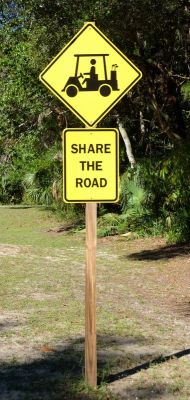9 Reasons Safety Leadership Is Like Golf
Safety leaders focus in the present and on what they are doing in the moment.
 With Labor Day on its way this weekend, many will be hitting the golf links. The subject of safety leadership is normally a serious one. But, I thought that we could venture a little off-road and have a look at safety leadership from a different perspective.
With Labor Day on its way this weekend, many will be hitting the golf links. The subject of safety leadership is normally a serious one. But, I thought that we could venture a little off-road and have a look at safety leadership from a different perspective.
Each of the points should be fairly evident and provide you with a new way to connect something fun with something serious. Let's play the front-nine. Here are nine reasons that safety leadership is like golf:
1Know the rules. If you don’t know the rules, you will fail at the etiquette part. Etiquette is the “how we do things ‘round here” of golf. Who putts first? Don’t step on the green in the line between the ball and the hole. Quiet when someone is about to swing. Golfers know the rules and they learn etiquette. When they don’t know the correct way, they ask.
2Focus on your shot. In other words, be present. If you’re not mentally focused, you’ll send your shot into the woods. Safety leaders focus on the present and on what they are doing in the moment. Golfers take practice swings in an effort to hone their concentration. A safety leader’s practice swing is a Job Hazard Assessment (JHA). Focus on what you’re about to do and find your best effort the first time.
3Choose the right club. You wouldn’t use a driver when a sand wedge is called for. Safety leaders use the right tool for the job. There’s no room for McGyver on a job site. (McGyver was an American TV show about an agent who solved complex problems by making things out of ordinary objects.) Pliers are a poor choice when a pipe wrench is called for. Safety leaders use the right tool for the job.
4Plant your feet. The key to a successful golf swing starts with solid footing. Balance is important in golf. Safety leaders ensure that they are squared to the job with solid footing. Trying to work off-balance or at risk of a fall or slip means that tools can go flying and safety is compromised. Solid footing also includes working at height. A connected harness and fall protection gives a feeling of solid footing.
5Get a firm grip. This is the hand equivalent of having firm footing. There is a correct way and incorrect way to grip a golf club. The techniques are learned. The same goes for the operation of tools, equipment and anything your hands touch. There is always a right way and wrong way to work with your hands. Learn the right technique, and do only that.
6Keep your eye on the ball. In golf, the secret is to keep looking at the ball and only lift your eyes once the ball has been struck. It allows you to watch the ball all the way through to where it lands. Safety leaders also keep their eye on the ball and focus on the task at hand. Keeping eye contact with what you are doing reduces your risk of the task getting away from you. There is plenty of time to look up once the equipment you’re using has been shut off.
7Follow through. In golf, the follow-through of the swing is just as important as the moment of impact with the ball. Knowing that you’re following through means that you’re focused on technique and balance. Safety leaders follow-through as well. They don’t complete the work and not follow-through to clean up their workspace. Paperwork is part of follow-through. So is communication.
8Enjoy the course you’ve chosen to play. You can’t play two golf courses at the same time. Nor can you be focused on two things at the same time. You’re in your job and whether you like it or not, you are there. Enjoy the course you’ve chosen to play. Safety leaders commit to giving their very best performance regardless of their feelings for the job. You are where you are. Give your best.
9Golf, like safety, has hazards. In golf, hazards can include ponds, sand traps and sometimes snakes or alligators. But with every hazard is a solution to recover. When hazards are present, safety leaders depend on their training and on taking time to assess their options. Just like golf. There are always options. They may not always be pleasant options but there are always options. In every instance, make wise and safe choices.
 So, when you’re on the course this weekend, or you’re involved in any activity, pay attention to how you are playing the game. Be a safety leader.
So, when you’re on the course this weekend, or you’re involved in any activity, pay attention to how you are playing the game. Be a safety leader.
Kevin Burns gives engaging, entertaining and inspiring presentations to front-line employees at safety meetings. He also works with supervisors and managers on-site or in keynote presentations at conferences. Kevin helps organizations integrate caring for and valuing employees through their safety programs. Kevin Burns is a management consultant, safety leadership speaker and author of 9 books. He is based in Calgary, Canada.
©2016 ZeroSpeak Corporation and Kevin Burns.
No part of this post may be reproduced without the expressed consent of the author.


